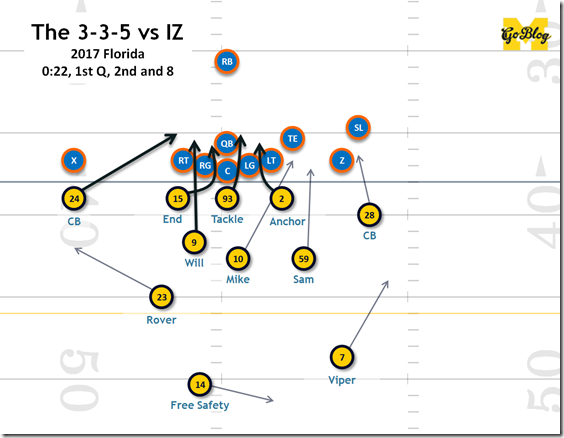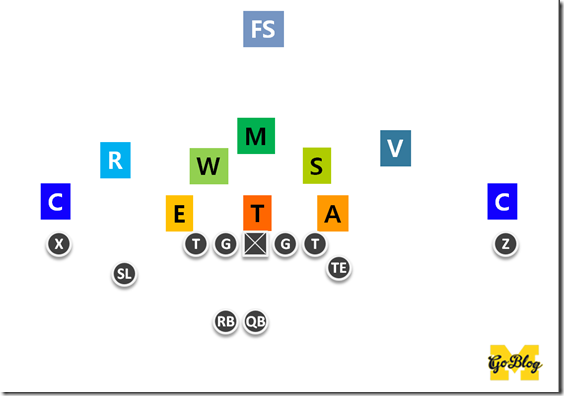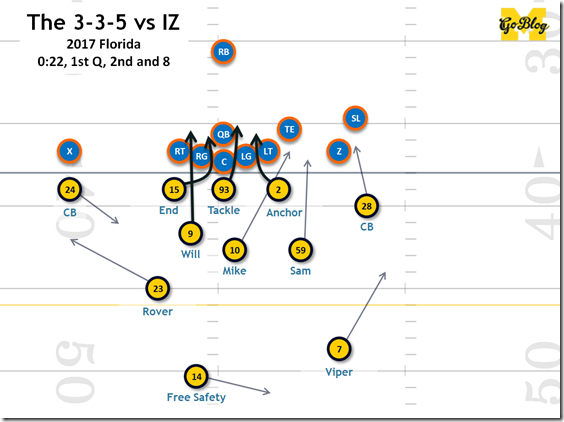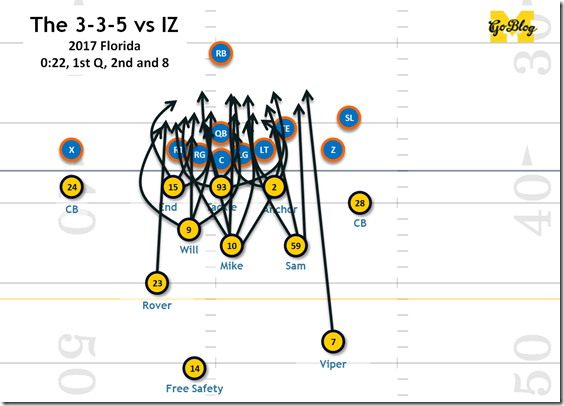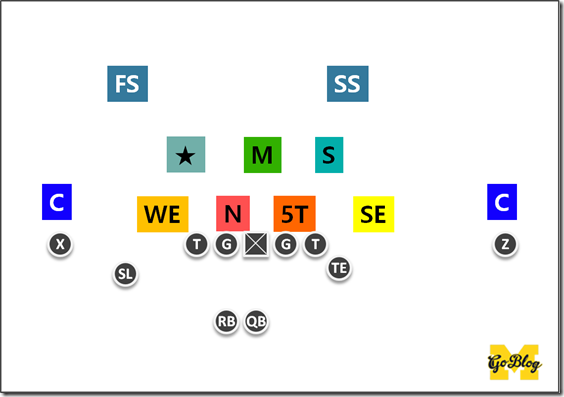This series is a work-in-progress glossary of football concepts we tend to talk about in these pages. Previously:
Offensive concepts:RPOs, high-low, snag, covered/ineligible receivers, Duo, zone vs gap blocking, zone stretch,split zone, pin and pull, inverted veer, reach block, kickout block, wham block, Y banana play, TRAIN, the run & shoot
Defensive concepts: The 3-3-5, Contain & lane integrity, force player, hybrid space player, no YOU’RE a 3-4!, scrape exchange, Tampa 2, Saban-style pattern-matching, match quarters, Dantonio’s quarters, Don Brown’s 4-DL packages and 3-DL packages, Bear
Special Teams: Spread punt vs NFL-style
----------------------------------
We’ve been writing under the assumption that our readers were all around for the early Rich Rodriguez years, and bought the edition of HTTV where Chris Brown described how Rodriguez-era West Virginia DC Jeff Casteel’s version of it worked. Now that it appears to be Michigan’s base defense (at least versus spread and option teams), maybe it’s time for a refresher.
----------------------------------
A PLAY:
Here’s the most common offensive play in football, Inside Zone, getting straight-up murdered:
The idea here is there’s always (mostly) a linebacker blitzing to be the 4th DL. Functionally McCray is a lineman, but if you’re the offense you don’t know that. Watch the right guard, #74, get totally discombobulated at this discovery.
My drawing here shows the run fits and the Don Brown version of the terminology. This particular play had a few variants:
- The two ends are a little offset and Winovich motions inside on the play: that’s because those guys are both taking interior gaps.
- The CB blitzed.
Only the first thing is interesting for understanding a 3-3-5. This defense, at its heart, is a one-gap, 4-2-5, except it trades the beef up front of a 4-man line for never knowing who’s in what gap or even who’s going to be the 4th lineman.
[Hit THE JUMP for a very short explanation of the jobs]
----------------------------------
WORKING DEFINITION
The 3-3-5 defense is foremost a personnel grouping with three down linemen, three linebackers, and five defensive backs:
I color-coded here to orient you on the spectrum of beefosity to speed, figuring red is a planet, yellow is a DE, green is a linebacker, blue is a cornerback. You can tell right away that we’ve got a lot of hybrids in here. Nobody’s red, the outside linebackers shade yellow, the middle linebacker has a blue hinge, and the safeties have some green. Let’s walk through each spot, referring back to the personnel on the field in the clip I used:
Nose: There ain’t no nose on the field. A 3-3-5 is welcome to function like a 3-4 defense with a two-gapping planet, but Don Brown’s 3-3-5 defense is a one-gap D that removes the nose (Mone) for a linebacker (Furbush). So let’s move on to the next job which is on the field.
Tackle: Lines up over the center in a 0- or 1-technique, which means he doesn’t betray which gap he’s attacking. Michigan’s normal 3-tech is Mo Hurst—in the clip above it’s his backup Lawrence Marshall, which really drives home the fact that we are not putting the Nose Tackle depth chart on the field. The tackle needs a quick first step to attack his gap as soon as the ball is snapped,
Anchor: Normally Gary, and Kemp in the clip we used, this job is unchanged from the 4-2-5’s strongside end position that Wormley played last year. The Anchor lines up off the strongside offensive tackle (a 5-technique) or maybe off the TE’s inside shoulder. He’s part beefy lineman, able to dominate doubles from the OT and TE or what have you, and part pass-rushing DE.
End: The weakside defensive end, Chase Winovich. He can be more pass-rushy but in a 3-3-5 or a 4-2-5 this guy needs to be able to play Anchor when the offense motions the TE to the other side.
Sam: In for the nose, this is the personnel change that makes a difference between the 4-2-5 and 3-3-5. You’re looking at a Jake Ryan-esque linebacker/defensive end tweener. You want a really athletic guy with good burst because he’s going to be your most common blitzer. The Sam might cover a tight end in coverage, or appear in all sorts of gaps with a mean head of steam. Michigan’s Sam is Noah Furbush.
Will: Another difference between the 3-3-5 and the base 4-2-5 is the WLB can be more of a Sam—by which I mean just like the Sam you’re going to regularly be blitzing the Will to act as a 4th defensive lineman who shows up anywhere. This is a good fit for Mike McCray, who’s more effective as a burly straight-ahead blitzer than a spacebacker.
Mike: A 3-3-5 Mike takes on some of the pass coverage and read-and-react stuff that often gets spread among the MLB and WLB in a 4-2-5. The biggest mistake Greg Robinson made was lining Kenny Demens just a yard or two from the line of scrimmage. You want your 3-3-5 Mike to be more like 5-7 yards off, where he can read the play and shoot past blockers or defend the pass. You can also have him be the blitzer—you never know where the pressure’s coming from. Devin Bush is perfect for this job as a tiny, ready-and-reacty dude who’ll insert his face in gaps.
Viper: The Rocky Long 3-3-5 coaches called this a “Spur” if you remember the nomenclature from when Stevie Brown played this. It’s exactly the same as Michigan’s 4-2-5 Viper. He lines up over the tight end side, hence the “eats his meat raw” description. Khaleke Hudson was born to be the Viper.
Rover: We used to call this the Bandit. He’s not very different from a Viper, except he’s not dealing with tight ends—he’s more likely to be over a slot receiver, so you’re looking at nickelback-like characteristics in addition to the general strong safety-ness. Michigan’s been using Kinnel and Metellus interchangably here.
Free Safety and Cornerbacks: No change.
----------------------------------
HOW DOES IT WORK?
I’ll save you a scroll:
The 3-3-5 is not just a nickel defense—it’s more like a one-gap 3-4 that sacrifices weight for surprise.
Offenses look for clues from the defense’s alignment to know what their jobs are gonna be. On inside zone for example the offensive linemen identify whether they’re covered or not to know ahead of the snap if they’re going to combo which guy and how. Option offenses like Air Force’s will all want to agree who they’re optioning.
Trying to make those identifications gets tougher the better the defense can disguise who’s in what gap, and the 3-3-5 is an extreme version of that. You can have any linebacker or even the safeties very often appearing in a base run gap, and the alignment leaves little clue who or where that guy will show up. If you haven’t practiced for it, your guys are going to miss assignments a lot.
Basically this:
…to the offense looks like this:
----------------------------------
QUESTIONS
What’s a 3-3-5 stack?
It’s a way of aligning in a 3-3-5 that favors different personnel. The clip I showed functions like a stack. Teams that run the stack are more 3-4ish in how their defensive linemen play. A stack team plays with thicker DL who are less about getting upfield and more about preventing the OL from getting to the linebackers. That lets you use thinner linebackers, but you get less pass rush from your DL. See how Winovich and Kemp were taking inside gaps? That’s very common from a stack. Consider it a slider.
Is this like a 3-3-5 nickel?
If you mean Michigan’s nickel defense under Greg Mattison, sorta, but no:
That was a nickel defense with Jake Ryan playing defensive end. There wasn’t a lot of surprise where guys were coming from except when they went to an Okie. The Rover equivalent was Blake Countess, who wasn’t a threat to blitz as much as Kinnel/Metellus, who are often taking an edge. The 2011 defense wasn’t all about “good luck guessing who’s attacking” it was “I’m sending Jake Ryan off your edge, good luck with that.”
What’s the downside?
You’re still playing with less mass on the field. If the offense figures out what you’re up to, now you’ve got large linemen reacting instantly to smaller players. The (still-a-one-gap) philosophical opposite of a 3-3-5 might be the 4-3 defense that Michigan State was so successful with in the Dantonio-Narduzzi era:
This left little surprise what any defender was going to do on any play, but those defenders were very specifically recruited and developed to play the roles they would play every down. The strongside end would be a vicious pass-rusher and big and tall enough to really put a TE off his route if he tried to release into one. The DTs would shoot upfield at (or before) the snap and really nerfed what you could do with your guards. The weakside end was excellent in space and very responsible, making it very hard to play games with the backside. The outside linebackers are good pass defenders and evil blitzers. The Mike is a fast reader, good at aligning everybody, and able to ably handle both A gaps. Every play these guys grab their lunch pails and report to the gaps they were born to play.
A 3-3-5 asks lots of players to do different things. The clip I used here shows a good example because Winovich, your nominal pass-rushing DE, is taking an A gap, where two plug uglies are set up to double-team with a running back coming straight downhill. A 3-3-5 without the element of surprise is Michigan’s 2010 defense: undersized dudes with no momentum getting mauled by larger players. For those of you who’ve already been through all the therapy it takes to forget that, it looks like this:
This is Cincinnati running the same play Florida did in the first clip, but Michigan here mistimed their setup (and Cincy had an inkling before the game that Michigan was going to do this) so the UC guard and center are ready and have size on their side, meaning Winovich and McCray get taken for a ride, and the back gets a date with a filling safety for all the yards.
